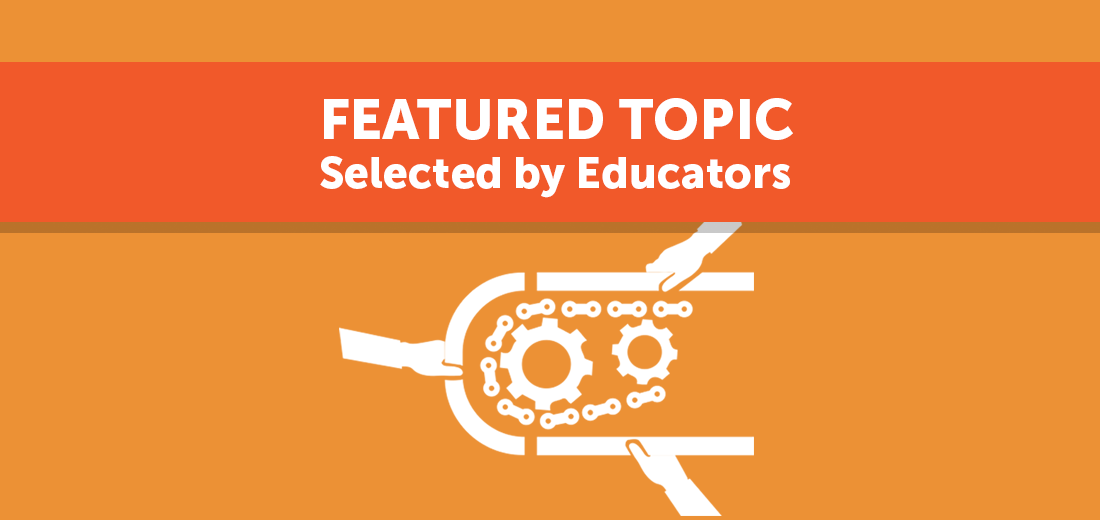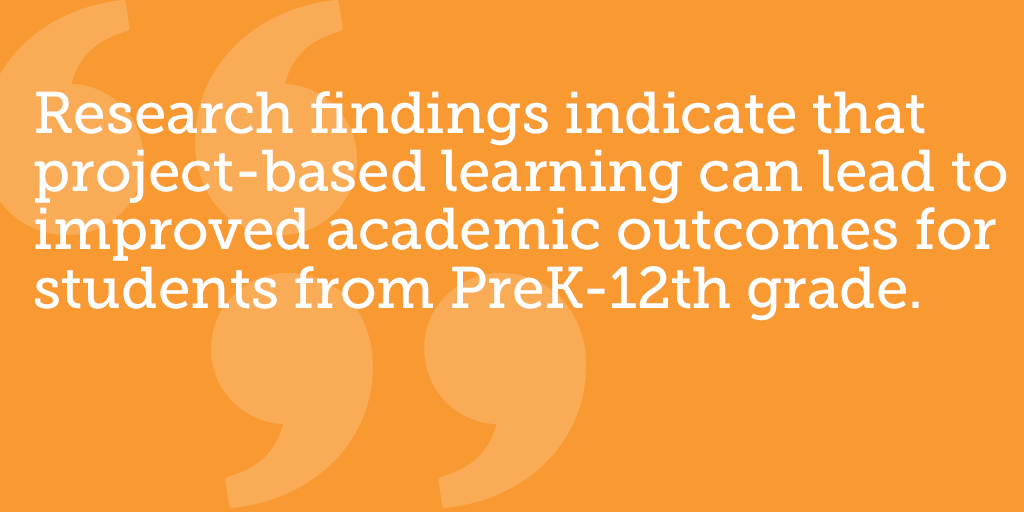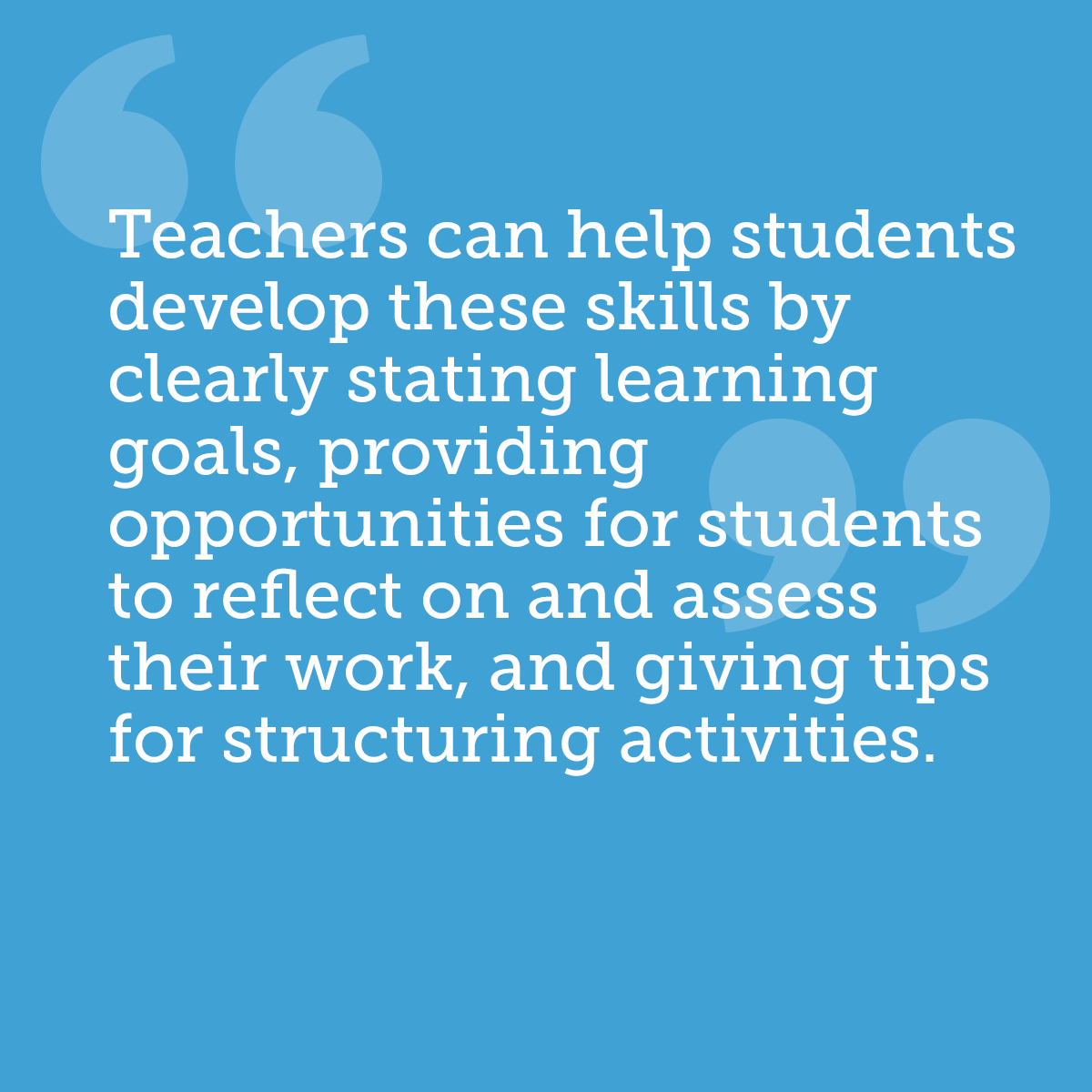
Can adopting a project-based learning approach affect student outcomes?
In the early 20th century, education pioneers such as John Dewey advocated for active, experiential approaches that placed students at the center of the learning process. In 1918, William Heard Kilpatrick built on Dewey’s theory to design the project method, which incorporated student projects into the curriculum.[i] Later in the 1950s, Jean Piaget’s constructivist theory lent further support to active, experiential learning with its description of how children construct their own knowledge through personal experience with the world.[ii]
The use of projects to engage students in active, authentic learning fell out of favor in the 1960s and 70s, but found a resurgence in the 1980s as researchers published new findings on student motivation, the development of expertise, and learning contexts.[iii]
There are a variety of pedagogical approaches related to project-based learning, such as challenge-based learning, problem-based learning, and inquiry-based learning. These approaches share common features. They: (1) pose an authentic problem or question; (2) engage students in investigations or design activities; (3) result in a final product; (4) involve student collaboration; and in many cases, (5) use learning technologies.[i]
When implemented well, these engaging, authentic, and inquiry-based approaches can benefit students from all backgrounds and levels of achievement.[iv, v] They can also be implemented in a variety of contexts, from individual classrooms to entire schools.[vi] In the next section, we share key research findings on student outcomes and how to successfully implement project-based learning approaches.
The sections below highlight key findings from the research on PBL Outcomes and Implementation.
Project-Based Learning can improve students’ academic achievement.
 Research findings indicate that project-based learning can lead to improved academic outcomes for students from pre-kindergarten-12th grade.[iv] For example, in some studies, students who participated in a project-based learning program performed better than traditionally-taught peers in content knowledge and understanding.[ii, iv] These findings were consistent for students at varying levels of achievement [v] and ability [vii]. There is also evidence that project-based learning can improve students’ ability to transfer learning to new situations.[viii] The majority of studies are in social studies and science, but there is some initial evidence to show its success in math as well.[vi]
Research findings indicate that project-based learning can lead to improved academic outcomes for students from pre-kindergarten-12th grade.[iv] For example, in some studies, students who participated in a project-based learning program performed better than traditionally-taught peers in content knowledge and understanding.[ii, iv] These findings were consistent for students at varying levels of achievement [v] and ability [vii]. There is also evidence that project-based learning can improve students’ ability to transfer learning to new situations.[viii] The majority of studies are in social studies and science, but there is some initial evidence to show its success in math as well.[vi]
Project-Based Learning can enhance students’ interpersonal and intrapersonal development.
Project-based learning can offer students a multitude of benefits that extend beyond academic performance. For example, students who participate in project-based learning have shown increased engagement in learning [viii, iv] and improved problem solving skills.[viii, ii] There is also research on the potential of project-based learning to support students’ identity development as they navigate a project environment that calls for both autonomy and collaborative work.[ix, x] And, as students work together in a sustained team, they can improve their collaboration skills, which is essential for professional work.[ii, viii]
Teachers need to adopt new roles and methods for project-based learning.
Some researchers caution that without proper guidance, students may follow misconceptions and have too many false starts in project-based learning.[iv] Further, there is a danger of adopting projects that may be appealing or engaging, but not aligned with learning goals.[ii] Therefore, it is essential that educators be trained to implement project-based learning successfully. For example, teachers need to shift to an advisor or facilitator role [iv], so they can provide the right support for each student to meaningfully participate in a group project.[ii, viii] They also need to learn new technologies that students will use for their projects [vi, xi], and how to craft a driving question or challenge that it is aligned with course learning goals.[xii]
Students require support to actively participate in and benefit from project-based learning.
 Like educators, students too need new skills to adapt to project-based learning. Specifically, students need support to become self-regulated learners who can set goals, monitor and assess their own progress, and stay motivated.[xiii] Teachers can help students develop these skills by clearly stating learning goals, providing opportunities for students to reflect on and assess their work, and giving tips for structuring activities.[xiii] This is especially true for lower-achieving students or those from lower socioeconomic backgrounds, who may need more coaching in how to guide their own learning.[v] Further, students need support to work in collaborative groups. To do this, educators can establish classroom norms and procedures for group work [vi], offer formative feedback on group performance, and encourage students to take on different group roles throughout the project.[viii]
Like educators, students too need new skills to adapt to project-based learning. Specifically, students need support to become self-regulated learners who can set goals, monitor and assess their own progress, and stay motivated.[xiii] Teachers can help students develop these skills by clearly stating learning goals, providing opportunities for students to reflect on and assess their work, and giving tips for structuring activities.[xiii] This is especially true for lower-achieving students or those from lower socioeconomic backgrounds, who may need more coaching in how to guide their own learning.[v] Further, students need support to work in collaborative groups. To do this, educators can establish classroom norms and procedures for group work [vi], offer formative feedback on group performance, and encourage students to take on different group roles throughout the project.[viii]
Multiple forms of assessment can be useful in project-based learning.
Research in project-based learning supports the use of regular, low-stakes feedback throughout the project (formative assessment), in addition to a final evaluation (summative assessment).[xiv] Several studies also point to the benefits of offering students formative feedback from a variety of sources, including instructors, peers, and their own self-reflections.[xii, xiv] Technology tools such as e-portfolios can help students document their reflections and share their progress with others.[xv, xvi]
Citations
[i] Hasni, Abdelkrim, Fatima Bousadra, Vincent Belletête, Ahmed Benabdallah, Marie-Claude Nicole, and Nancy Dumais. 2016. “Trends in Research on Project-Based Science and Technology Teaching and Learning at K–12 Levels: A Systematic Review.” Studies in Science Education 52 (2). Routledge:199–231.
[ii] Ackermann, E. n.d. Piaget’s Constructivism, Papert’s Constructionism: What’s the difference? Accessed January 30, 2018. https://learning.media.mit.edu/content/publications/EA.Piaget%20_%20Papert.pdf
[iii] Thomas, John W. 2000. “A Review of Research on Project-Based Learning.”
[iv] Holm, Margaret. 2011. “PROJECT-BASED INSTRUCTION: A Review of the Literature on Effectiveness in Prekindergarten through 12th Grade Classrooms.” Rivier College.
[v] Boaler, Jo. 2002. “Learning from Teaching: Exploring the Relationship between Reform Curriculum and Equity.” Journal for Research in Mathematics Education 33 (4). National Council of Teachers of Mathematics:239–58.
[vi] Condliffe B, Quint, J, Visher M G, Bangser M R, Drohojowska S, Saco L, Nelson E. 2017. “Project-Based Learning: A Literature Review.” https://s3-us-west-1.amazonaws.com/ler/MDRC+PBL+Literature+Review.pdf.
[vii] Halvorsen, A L, Duke N K, Brugar K, Block M, Strachan S, and Berka M. 2012. “Narrowing the Achievement Gap in Second-Grade Social Studies and Content Area Literacy: The Promise of a Project-Based Approach.” https://files.eric.ed.gov/fulltext/ED537157.pdf
[viii] Barron B & Darling Hammond, L. 1998. “Teaching for Meaningful Learning: A Review of Research on Inquiry and Cooperative Learning. Edutopia. https://backend.edutopia.org/sites/default/files/pdfs/edutopia-teaching-for-meaningful-learning.pdf
[ix] Langer-Osuna, Jennifer M. 2011. “How Brianna Became Bossy and Kofi Came Out Smart: Understanding the Trajectories of Identity and Engagement for Two Group Leaders in a Project-Based Mathematics Classroom.” Canadian Journal of Science, Mathematics and Technology Education 11 (3). Routledge:207–25.
[x] Langer-Osuna, Jennifer M. 2015. “From Getting ‘Fired’ to Becoming a Collaborator: A Case of the Co-construction of Identity and Engagement in a Project-Based Mathematics Classroom.” Journal of the Learning Sciences 24 (1). Routledge:53–92.
[xi] Seo K K, Templeton R, and Pellegrino D. 2008. “Creating a Ripple Effect: Incorporating Multimedia-Assisted Project-Based Learning in Teacher Education.” Theory into Practice 47 (3). Taylor & Francis, Ltd.:259–65.
[xii] Barron B, Schwartz D L, Vye N J, Moore A, Petrosino A, Zech L, Bransford J D, and The Cognition and Technology Group at Vanderbilt. 1998. “Doing with Understanding: Lessons from Research on Problem- and Project-Based Learning.” The Journal of the Learning Sciences 7 (3/4). Taylor & Francis, Ltd.:271–311.
[xiii] English, M C, and Kitsantas A. 2013. “Supporting Student Self-Regulated Learning in Problem- and Project-Based Learning.” Interdisciplinary Journal of Problem-Based Learning 7 (2). Purdue University Press:6.
[xiv] Trauth-Nare A, and Buck G. 2011. “Assessment for Learning: Using Formative Assessment in Problem – and Project-Based Learning.” The Science Teacher 78 (1). National Science Teachers Association:34–39.
[xv] Yang M, Tai M, and Lim C P. 2016. “The Role of E-Portfolios in Supporting Productive Learning.” British Journal of Educational Technology: Journal of the Council for Educational Technology 47 (6). Wiley Online Library:1276–86.
[xvi] Keune A, and Peppler K. 2017. “Maker Portfolios as Learning and Community-Building Tools Inside and Outside Makerspaces.” CSCL 2017 Proceedings. https://kpeppler.com/Docs/2017_MakerPortfoliosAsTools_CSCL.pdf.